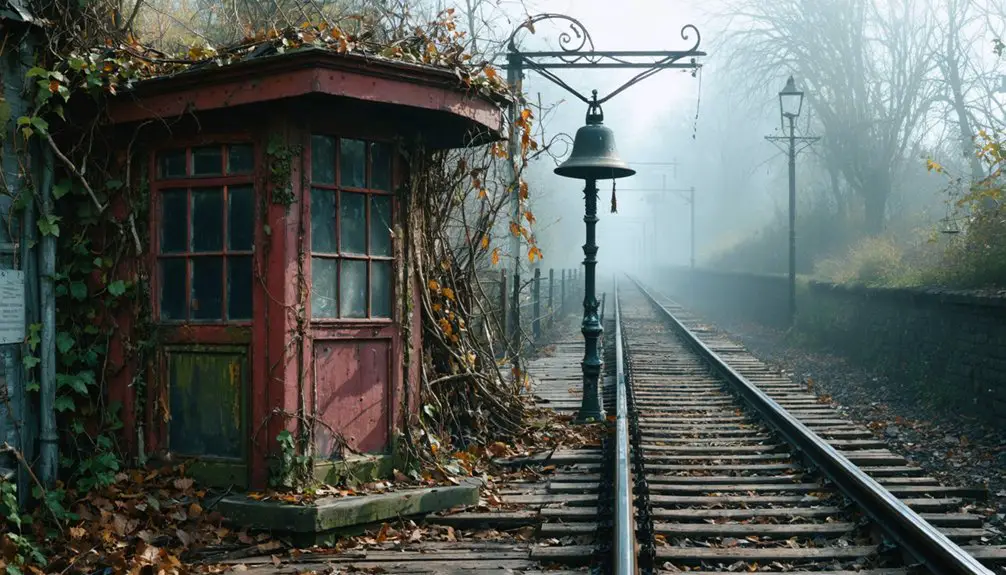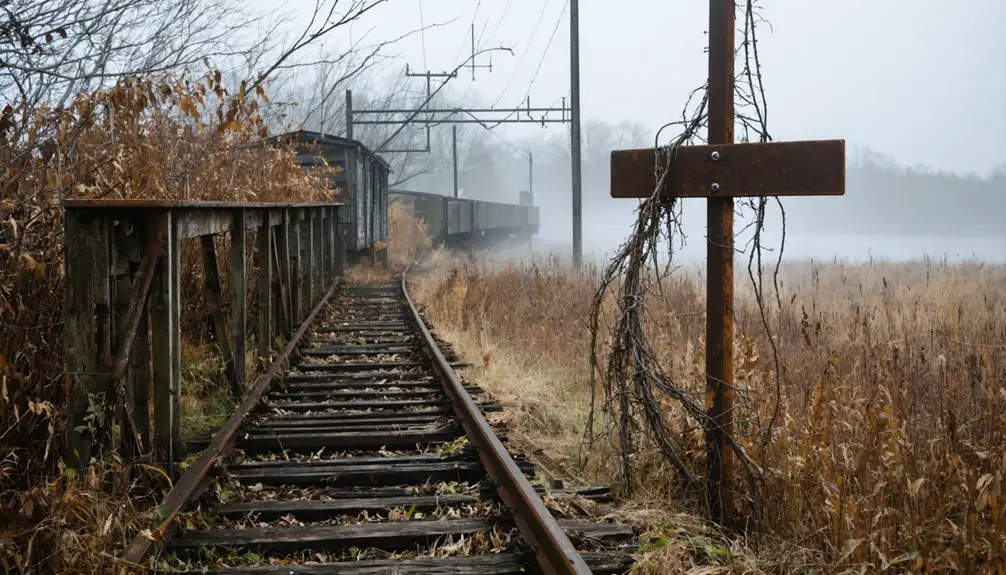You’ll find Tiverton Station tucked away in Rhode Island’s forgotten railway landscape, where the Old Colony Railroad‘s Boston to Newport line once thrived in the 1860s. The Victorian-era station, built with local granite and distinctive cast iron columns, served as an essential link between major New England economic hubs. Today, this ghost town’s abandoned platforms and weathered structures tell stories of bustling commerce, Revolutionary War movements, and the region’s vanished rail glory.
Key Takeaways
- Tiverton Station transformed from a bustling railroad hub in 1863 to near abandonment after rail service declined in the early 20th century.
- The 1916 station building remains largely intact but deteriorated, serving as a reminder of the area’s former railroad prosperity.
- Following railroad closure, local industries like textile mills and jewelry makers relocated, leading to population decline around the station area.
- The original Victorian architecture and granite platform stand preserved but unused, creating a ghost town atmosphere at the former transit hub.
- While the surrounding Tiverton town thrives, the station area remains largely deserted, with minimal commercial or residential activity.
The Rise and Fall of a Historic Railway Hub
When the Old Colony Railroad extended its Boston to Fall River line to Newport in 1863, Tiverton emerged as an essential link in New England’s expanding rail network.
Like the Providence and Worcester Railroad, which helped stimulate commercial growth throughout Rhode Island and Massachusetts, Tiverton’s rail connections sparked new business opportunities in the region.
You’d have witnessed remarkable railroad innovation as the Sakonnet River Rail Bridge, first built in 1864, connected Tiverton to Portsmouth, enabling seamless transport across the waterway. After decades of service, the Pennsylvania Steel Company constructed a new span in 1899.
The town’s strategic position fueled industrial growth throughout the region, with textile mills, jewelry makers, and metal works flourishing along the rail corridor.
You could’ve seen freight and passenger trains bustling through Tiverton’s station, connecting smaller communities to economic powerhouses like Worcester and Providence.
But after an overweight military train damaged the bridge in 1980, Tiverton’s glory days as a rail hub came to an abrupt end, leaving behind silent tracks and fading memories of its railroad heritage.
Native American Origins to Colonial Settlement
Before you’ll find any trace of Tiverton Station’s railway history, you’d need to look back to the Pocasset Wampanoag people who first established settlements here, drawn by the rich shellfish beds and abundant wildlife along Narragansett Bay.
The area holds deep ancestral significance as the site of The Battle in Tiverton during King Philip’s War, marking one of the most devastating conflicts for native peoples in the region’s history.
By the early 1600s, the area had transformed into a vibrant trading post where Native Americans and European settlers exchanged wampum and goods, with fortifications marking key points of commerce and defense. The land would later become home to first Indian reservation in the United States, established in the early 1700s.
Your journey through time would then witness Plymouth Colony’s expansion into these lands through Governor Bradford’s 1629 purchase from the Pocasset Tribe, setting the stage for Tiverton’s colonial development.
Early Indigenous Settlement Patterns
The Pocasset Tribe of the Wampanoags established the first permanent settlements in what would become Tiverton, drawn to the area’s mild climate, abundant wildlife, and rich shellfish beds along the coast.
Their indigenous lifestyles centered around a strategic migratory pattern that maximized nature’s resources throughout the year. Local settlements often included defensive trading posts that served dual purposes for commerce and protection. The area became home to first formal reservation in the United States during the 18th century.
You’ll find evidence of their sophisticated land use through:
- Seasonal shoreline settlements for fishing and crop cultivation
- Forest encampments for hunting and winter protection
- Strategic positioning near shellfish beds and berry-rich areas
These early inhabitants moved freely between coastal and inland areas, adapting their settlements to match natural cycles.
While visible traces of their presence are limited today, their influence shaped Tiverton’s earliest geography, with the establishment of America’s first Indian Reservation later marking their enduring connection to this land.
Colonial Trading Post Growth
Building upon the Pocasset’s established presence, colonial settlement in Tiverton began formally in 1629 when Plymouth Colony Governor William Bradford purchased the land from the Wampanoag tribe.
The area’s trading post dynamics quickly emerged as an essential hub for colonial commerce, featuring a fort that served both defensive and mercantile purposes. The post’s strategic location along the New England coast made it a vital economic center.
You’ll find evidence of early European influence in the fort’s architecture, possibly dating to Portuguese traders in 1520 or Dutch merchants in 1627.
The trading post facilitated significant exchanges between Native Americans and colonists, with wampum shell beads playing a central role in regional trade networks.
Plymouth Colony Expansion Claims
While Native American tribes, primarily the Wampanoag Confederacy, maintained sovereign control over the region’s coastal and riverine territories, Plymouth Colony’s expansion claims began reshaping the landscape after 1620.
You’ll find that Plymouth’s territorial growth faced several challenges as the colony pushed outward without a formal charter. The colonists’ expansion efforts relied on three key approaches:
- “Purchasing” lands through treaties with Native Americans
- Establishing boundary agreements with neighboring colonies
- Seeking legal recognition through English crown patents
Despite the Wampanoag’s initial aid in helping settlers survive, Plymouth’s expansion claims often conflicted with Native American concepts of land use, which focused on shared seasonal occupation rather than permanent ownership. The Mayflower Compact signers had established the first governing framework that would guide these territorial acquisitions.
The colony’s territorial ambitions stretched ambitiously from Nova Scotia to Pennsylvania, reflecting their grand vision of Protestant settlement in the New World.
These territorial disputes would continue even after Plymouth’s merger with Massachusetts Bay Colony in 1691.
Architecture and Design Features
When you visit Tiverton Station today, you’ll still see traces of its original Victorian-era layout, including the raised stone platform that once served passengers boarding steam locomotives.
The platform’s construction utilized locally quarried granite blocks, fitted together with remarkable precision and set on a packed gravel bed that allowed for proper drainage.
The station’s architectural features reflected standard New England railroad design of the 1860s, with wide wooden eaves protecting waiting passengers and distinctive cast iron support columns that remained standing long after regular service ended.
Original Victorian Layout
Throughout the late 19th century, Tiverton Station exemplified the grandeur of Victorian architectural design, with its structures primarily built between 1860 and 1900. The area’s status was further emphasized by the 1868 Union Library, which stood as a testament to the community’s commitment to learning and culture.
The Victorian layout featured distinctive side-hall and center-hall floor plans, breaking from traditional architectural symmetry to embrace a more dynamic aesthetic.
You’ll find these original homes showcased several specialized spaces, arranged in a hierarchy that reflected the social customs of the era:
- Ground floor parlors and formal dining rooms for entertaining
- Multiple bedrooms on upper floors to accommodate growing families
- Servant quarters strategically positioned for household efficiency
The properties typically occupied rectangular lots, with main houses commanding street presence while carriage houses and work sheds were discretely positioned to the rear, maintaining the prestigious facade‘s visual dominance.
Platform Construction Techniques
The five principal construction techniques at Tiverton Station’s platforms showcased the evolution of Victorian railway engineering.
You’ll find the original wooden planks and timber framing supported by robust stone foundations, with carefully laid ballast and gravel beneath for superior drainage. Along the platform edges, they’d installed wrought iron borders for enhanced durability against constant wear.
The engineers incorporated advanced drainage techniques for that era, including strategically placed channels and culverts beneath the platforms.
You can still spot the remnants of the original non-slip surface treatments and the clever 2-degree incline that prevented water pooling.
They’d also built earthen berms around the platform’s base, protecting it from the seasonal flooding that plagued Rhode Island’s coastal stations during the Victorian period.
Golden Age of Rail Transportation

Following the Civil War‘s conclusion in 1865, America entered an unprecedented era of rail expansion that would fundamentally reshape the nation’s landscape and economy. The explosive growth of railroad infrastructure saw trackage surge from 35,000 miles to over 254,000 miles by 1916, transforming how you’d travel and conduct business across the continent.
Key technological advancements revolutionized rail transport:
- Standard gauge adoption allowed seamless travel between different rail lines
- Steel rails replaced iron, enabling heavier loads and faster speeds
- Air brakes and automatic couplers dramatically improved safety
You’d now find yourself able to cross the country in days instead of months, paying just a tenth of what stagecoach travel cost.
This golden age of railroads brought unprecedented freedom of movement, connecting even the most remote communities to the national marketplace.
Revolutionary War Connections
While rail lines would later connect America’s expanding frontiers, Tiverton’s strategic importance emerged during a different era of movement – the American Revolution.
In 1777-1778, you’d have found an impressive military presence of 12,000-15,000 American troops stationed here, with revolutionary figures like Paul Revere, Lafayette, and John Hancock coordinating operations from Tiverton Heights.
The area that would later become Tiverton Station served as a significant mustering point near Howland’s Ferry, where troops monitored British movements on Aquidneck Island.
From Fort Barton’s elevated position 100 feet above sea level, American forces maintained strategic control of essential water crossings.
During the Battle of Rhode Island in August 1778, this location proved indispensable for the Continental Army’s successful retreat when French naval support was forced to withdraw.
The Station’s Decline in the Automobile Era

As automobiles transformed American transportation in the early 20th century, Tiverton Station faced mounting challenges that would ultimately seal its fate.
The automobile influence hit Tiverton Station especially hard as Rhode Island’s auto manufacturing industry collapsed, with major producers like ALCO and Maxwell departing after 1913.
You’ll find three key factors that accelerated the station’s abandonment:
- The rise of personal car ownership shifted travel patterns away from rail
- Local economy evolved from industrial to suburban residential
- Rail companies reduced service due to declining passenger and freight traffic
Urban Explorers and Modern-Day Visitors
Today’s abandoned Tiverton Station draws a steady stream of urban explorers and history enthusiasts, transforming this once-bustling transportation hub into a sought-after destination for those seeking traces of New England’s railway past.
You’ll find multiple levels to explore, from the upper floor’s historic waiting room, barber shop, and restaurant to the lower track-level platforms.
Urban explorers document their abandoned exploration through drone footage and photography, sharing detailed floor plans and historical insights across social media platforms.
While the site’s ghost town status appeals to photographers and history buffs alike, you’ll need to exercise caution due to structural decay and unstable conditions.
The station’s deteriorating architecture and industrial ambiance offer unique opportunities for historical documentation, though safety concerns and restricted access require careful consideration before visiting.
Preservation Challenges and Future Prospects
Despite decades of neglect since its 1959 closure, Tiverton Station faces mounting preservation challenges that threaten its historic fabric and architectural significance.
You’ll find the 1916 structure battling coastal Rhode Island’s harsh elements, while limited preservation funding hampers urgent restoration efforts.
The station’s future depends on three critical factors:
Success in preserving this historic landmark rests on strategic partnerships, grassroots support, and innovative approaches to modern adaptation.
- Securing public-private partnerships and grants for restoration
- Increasing community involvement through local historical societies
- Implementing adaptive reuse strategies that balance preservation with modern needs
You can see the potential for transforming this historic gem into a vibrant community space, but it’ll require maneuvering through complex regulatory frameworks and building codes.
The success of any preservation effort hinges on strategic planning that addresses both structural deterioration and the need for sustainable, long-term maintenance solutions.
Legacy in Rhode Island’s Transportation History
The historic significance of Tiverton Station emerges from its essential role in Rhode Island’s 19th-century rail network. As part of the Old Colony Railroad system, you’ll find it represented a critical link between Boston and Newport, shaping the region’s transportation evolution through its strategic location and infrastructure.
The station’s influence extended beyond mere transit – it catalyzed Tiverton’s economic impact through textile manufacturing, fishing industries, and recreational development.
You can trace how the rail connection transformed the town’s character, attracting wealthy visitors and enabling urban growth while supporting traditional industries.
When the Sakonnet River bridge’s 1980 closure severed this significant link, it marked the end of an era in Rhode Island’s transportation history, leaving behind a legacy that showcases rail’s transformative power in shaping local communities.
Frequently Asked Questions
Are There Any Paranormal Activities Reported at Tiverton Station?
Like whispers in an empty hall, you won’t find documented ghost sightings or eerie sounds here. Historical records and paranormal investigations show no confirmed supernatural activity at this abandoned transportation hub.
What Artifacts Have Been Found by Explorers at the Abandoned Station?
You’ll discover abandoned relics from the historic railroad era, including track segments, crossing gates, station building foundations, and scattered train operation equipment that holds significant historical value.
Did Any Notable Historical Figures Pass Through Tiverton Station?
While you won’t find records of nationally famous travelers here, local notables like Job Durfee and Jonathan Bourne likely used this railway stop during its peak regional significance in the 1800s.
Can Visitors Legally Access the Station Grounds Today?
In 90% of Rhode Island ghost towns, you’ll need explicit permission for entry. You can’t legally access these grounds without first obtaining proper clearance through local authorities or property owners.
Were There Any Major Accidents or Incidents at the Station?
You’ll find reports of several vehicle accidents near the station area, including a major three-car crash in 2025 and a notable 1976 plane crash nearby, though none occurred directly at the station itself.
References
- https://www.youtube.com/watch?v=mnlAArcGj1A
- https://preservation.ri.gov/sites/g/files/xkgbur406/files/pdfs_zips_downloads/survey_pdfs/tiverton.pdf
- http://freepages.rootsweb.com/~gtusa/history/usa/ri.htm
- https://www.worldatlas.com/cities/6-of-the-quirkiest-towns-in-rhode-island.html
- https://www.youtube.com/watch?v=PeehoMoCGdo
- https://sites.google.com/site/rhodeislandrailroads/home/east-providence-south/east-providence-north/pwb-route/newport
- https://en.wikipedia.org/wiki/Providence_and_Worcester_Railroad
- https://en.wikipedia.org/wiki/Sakonnet_River_rail_bridge
- https://www.achp.gov/preserve-america/community/tiverton-rhode-island
- https://www.pocassetlandtrust.org/pocasset-wampanoag-tribe-of-the-pokanoket-nation-reclaims-40-acres-of-native-land-in-tiverton-rhode-island/



